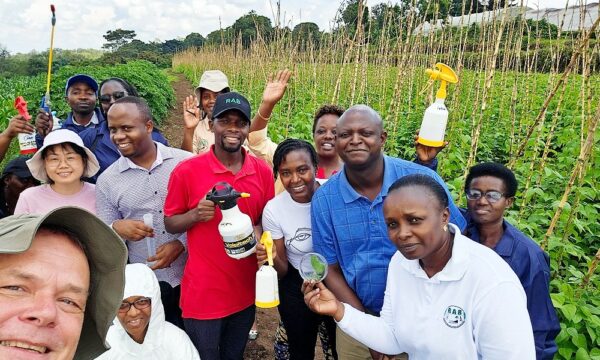Tutsan (Hypericum androsaemum) is invasive to New Zealand and Australia. Native to many countries throughout Europe and western parts of Asia, it is thought to have been introduced as a garden ornamental by acclimatisation societies in the 1800s due to its attractive yellow flower. Today, tutsan is a severe weed in several regions of New Zealand, most significantly affecting the Ruapehu District and Bay of Plenty region in the North Island. Over the last 20 years, tutsan has become an increasing problem in these regions; spreading throughout low fertility pastures and along roadsides. There is concern that tutsan has the potential to pose a significant conservation threat if it continues to spread at its current rate through scrub and native forest fringes.
Recent estimates indicate that around 150,000 ha of land in the Ruapehu district is affected by tutsan. Within the district, the annual cost of controlling the weed, and loss of farming profit amount to around $NZ1.2 million (£600,000), and loss of current land values is estimated at $NZ27 million (£13 million). Tutsan is a persistent weed for which there are no registered chemicals. Off-label herbicides are currently used in an attempt to limit its spread, but these are proving ineffective with stands typically reappearing several years later. The weed is unpalatable to stock and the topography of the region’s worst affected areas further limits the control methods possible.

Tutsan growing on sheep pasture in the Ruapheu District of the North Island, NZ; the copper colour arises from a reddening of the leaves as the plant matures (photo: Lizzie Rendell, 2011)
In 2007 the Tutsan Action Group (TAG) was initiated, formed of local farmers, farm consultants, regional council Pest Plant Officers and representatives from the governmental Department of Conservation to tackle the growing problem. As well as carrying out their own work to raise awareness of tutsan throughout the region, TAG approached Landcare Research to ask for help and in 2009 a biological control programme was established through support from the Ministry for Primary Industries Sustainable Farming Fund.
To date the programme has consisted of an international effort between Landcare Research New Zealand, CABI Switzerland and more recently, CABI UK. Surveys have been carried out in both the invasive and native ranges of the plant to assess the extent of current populations and to identify potential biological control agents. In recent European surveys, a leaf beetle (Chrysolina abchasica) and a tortricid moth (Lathronympha strigana) were identified as having the potential to become biocontrol agents for tutsan and are currently being reared for host range testing by Landcare Research, under quarantine conditions in Lincoln, New Zealand.
The tutsan rust fungus, Melampsora hypericorum was also evident in surveys, both in the native range and in New Zealand. This pathogen has been known to provide control for tutsan populations in Victoria, Australia. In the early 1990s a biological control programme was initiated in Victoria since tutsan was affecting 67,000 ha in the Otaway Ranges. This programme was soon abandoned as surveys revealed that the rust fungus had self-introduced and was already controlling tutsan populations in this region; by 1993, surveys discovered only one live tutsan seedling. In recent times, tutsan is considered to be an increasing problem in Victoria, with the level of control provided by the rust fungus is currently unknown. Melampsora hypericorum is thought to be acting as an effective biological control agent in some parts of New Zealand, for example on some populations of the South Island, but remains ineffective in the regions worst affected. Molecular studies were conducted to establish where tutsan was originally introduced into New Zealand from, and revealed that several introductions are likely to have occurred. Plants in New Zealand’s North Island are likely to have been introduced from Wales or Ireland, and plants in the South Island from the UK, France or Spain. Genetic analysis of both plant and fungal material has also revealed that different genotypes of both tutsan and the rust occur in different regions across New Zealand. The range of genetic variation gives rise to a complex plant-fungal relationship which is playing a major role in the susceptibility of tutsan populations to M. hypericorum.
Current work at CABI, is focusing on assessing the virulence of 14 different strains of M. hypericorum collected from Europe and Georgia towards tutsan plants from New Zealand. Studies aim to find a strain that is more virulent towards the most problematic plant populations of tutsan that are not currently controlled by the rust. To date, the virulence of two strains of M. hypericorum have been assessed. A strain from Georgia failed to infect tutsan populations that are considered most problematic from the North Island. A strain collected from Pembrokeshire, Wales has produced a reliable infection on tutsan plants collected from four different New Zealand populations, including two populations which were ranked as having a high severity in 2011 surveys. Assessment of the remaining 12 rust isolates is currently ongoing.
Since little is currently known about M. hypericorum, trials are also being carried out to assess the infection parameters of the rust fungus. Free water availability and temperature are being investigated to determine the range and peak of these parameters for the species.

Tutsan in inoculation trials at CABI, Egham infected with the tutsan rust fungus, Melampsora hypericorum (photo: Lizzie Rendell, 2014)
Lizzie Rendell
Scientific Support
Related News & Blogs
Biological control in action: Zambia’s field days on fighting fall armyworm
Experts from CABI recently held two field days and an expo in Zambia, showcasing innovative approaches to pest management to 584 farmers, agro-dealers and other stakeholders to help raise awareness of approaches to tackle the invasive fall armyworm (Sp…
11 June 2025





